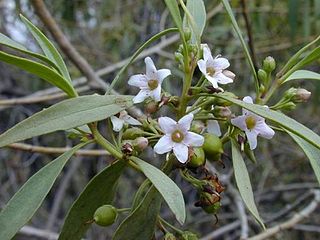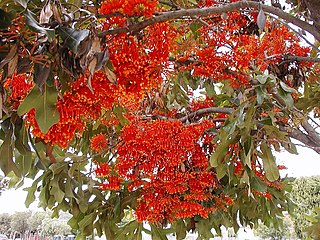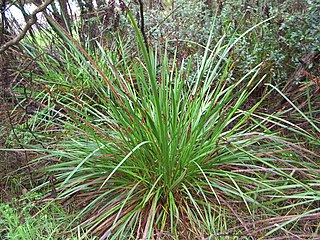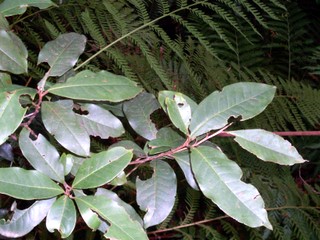
Knightia is a small genus of the family Proteaceae endemic to New Zealand, named in honor of Thomas Andrew Knight. One extant species, K. excelsa (rewarewa) is found in New Zealand. Two further Knightia species are found in New Caledonia, although they were placed in the genus Eucarpha by Lawrie Johnson and Barbara Briggs in their influential 1975 monograph "On the Proteaceae: the evolution and classification of a southern family", a placement supported in a 2006 classification of the Proteaceae. A fossil species from upper Miocene deposits in Kaikorai has been described as Knightia oblonga. Knightia has been placed in the tribe Roupaleae of the subfamily Grevilleoideae.

Myoporum is a genus of flowering plants in the figwort family, Scrophulariaceae. There are 30 species in the genus, eighteen of which are endemic to Australia although others are endemic to Pacific Islands, including New Zealand, and one is endemic to two Indian Ocean islands. They are shrubs or small trees with leaves that are arranged alternately and have white, occasionally pink flowers and a fruit that is a drupe.

Schefflera is a genus of flowering plants in the family Araliaceae with 13 species native to New Zealand and some Pacific islands.

Stenocarpus is a genus of about 22 species of flowering plants in the family Proteaceae. They are trees or shrubs with variably-shaped leaves, zygomorphic, bisexual flowers, the floral tube opening on the lower side before separating into four parts, followed by fruit that is usually a narrow oblong or cylindrical follicle.

Graptophyllum is a genus of plants in the family Acanthaceae. It includes 15 species with a disjunct distribution, with one species native to tropical Africa, and the others to New Guinea, Queensland, and the southwest Pacific Islands.

Polyscias is a genus of flowering plants in the family Araliaceae. They bear pinnately compound leaves.

Cerberiopsis is a genus of plant in the family Apocynaceae, first described as a genus in 1873. The entire group is endemic to New Caledonia. The genus is related to Cerbera.

Zygogynum is a genus of plant in the winter's bark family Winteraceae. 19 species are native to New Caledonia, and are pollinated primarily by beetles and moths. Other species are native to New Guinea, the Bismarck Archipelago, the Solomon Islands, Lord Howe Island, and Queensland.

Lepidosperma is a genus of flowering plant of the family Cyperaceae. Most of the species are endemic to Australia, with others native to southern China, southeast Asia, New Guinea, New Caledonia and New Zealand.

Myodocarpaceae is a family of flowering plants which contains 2 genera and 15 species. The family is accepted under the APG IV system and placed in the order Apiales. In earlier systems the two genera were included among the Araliaceae.

Parsonsia is a genus of woody vines in the family Apocynaceae. Species occur throughout Indomalaya, Australasia and Melanesia.
Velleia is a historically recognised genus of about 30 species of herbs in the family Goodeniaceae.

Styphelia is a genus of shrubs in the family Ericaceae, native from Indo-China through the Pacific to Australia. Most have minute or small leaves with a sharp tip, single, tube-shaped flowers arranged in leaf axils and with the ends of the petals rolled back with hairs in the inside of the tube.

Meiogyne is a genus of flowering plants with about 33 species belonging to the family Annonaceae. It is native from southwestern India and Indochina to Australia, including Fiji and New Caledonia.

Sannantha is a genus of flowering plants in the family Myrtaceae that are native to Australia and New Caledonia. Plants in the genus Sannantha are shrubs or trees with leaves arranged in opposite pairs, flowers usually arranged in small groups, the peduncles often 1.5–2 times as long as the pedicels and with seven to fourteen stamens. The fruit is a thin-walled capsule containing flattened, D-shaped seeds. Some species of Sannantha were previously included in the genus Babingtonia.

Atractocarpus is a genus of flowering plants in the family Rubiaceae. Its members are commonly known as native gardenias in Australia. The genus name is derived from the Ancient Greek terms atractos "spindle", and karpos "fruit", from the spindle-shaped fruit of the type species.

Quintinia is a genus of about 25 evergreen trees and shrubs native to the Philippines, New Guinea, New Zealand, New Caledonia, Vanuatu and Australia. Plants have alternate leaves. White or lilac flowers form at the end of stalks or on leaf axils. The fruiting body is a capsule, usually containing a large number of tiny seeds. The genus is named after the gardener Jean-Baptiste de la Quintinie.
Eucarpha is a genus of flowering plant of the family Proteaceae, endemic to New Caledonia. Two species are recognised. Up to 1975, these were classified within the genus Knightia until Lawrence Johnson and Barbara G. Briggs recognised their distinctness, particularly their prominent bracts, in their 1975 monograph "On the Proteaceae: the evolution and classification of a southern family". Nomenclatural combinations for these two species in the genus Eucarpha were published in 2022.

Deplanchea is a genus of about eight species of tropical rainforest trees, constituting part of the plant family Bignoniaceae.
















